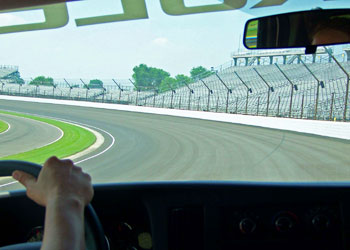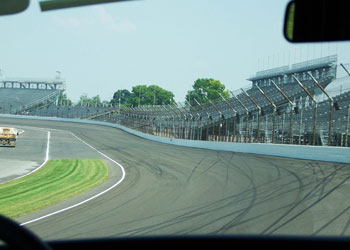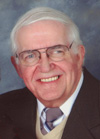
Be sure to take in the Speedway Museum at Indianapolis
By Richard Bauman
The first sporting event I remember listening to on the radio, as a youngster, was the Indianapolis 500 race from the Indianapolis Motor Speedway. Every Memorial Day my father and his brothers listened to the race in our kitchen as they played cards and drank beer.
I couldn’t imbibe, nor would they let me play pinochle with them, but I could sit quietly and listen to Sid Collins announce the race and hear the bellowing Offenhauser engine-powered racecars in the background. In my mind’s eye, I would visualize the “Greatest Spectacle in Racing.”
In my pre-adult days, I often daydreamed about seeing the race in person. Another fantasy was taking a lap on the track; rocketing down the back straight, diving through turn three into the short shoot that leads to turn four, whizzing through that turn and blasting onto the front straight, flashing past the pits on my left and the cheering crowd in the stands on my right.
I’ve yet to see an Indy 500 in person, but I have taken a lap on the track — and so can you. I didn’t rocket down the back straight or flash past the pits and fans on the front straight.

The lap my wife and I took on the asphalt of the Indianapolis Motor Speedway (IMS) was in a van, not a racecar. And our top speed was more like 25-35 mph rather than a breathtaking 200 mph.
Nonetheless, it was exciting to be on that track, go through the turns, and cross the start-finish line still marked by a row of bricks that for decades covered the entire surface of the 2.5-mile oval.
The Hall of Fame Museum
While we specifically wanted to take a lap on the track, we also wanted to see the Indianapolis Motor Speedway Hall of Fame Museum. In 1987, the museum and Speedway grounds were honored with the designation of National Historic Landmark.
I’d heard it was a fine automotive museum, but that’s an understatement. It’s an excellent museum, and while it has a section specifically dedicated to Indy cars, at least half the exhibits are devoted to other racecars, antique cars, and other vehicles of speed. There are about 75 different vehicles on display at any given time in the museum.
For example, The Chevrolet Corvette SS is displayed there. It was created by Zora Duntov for General Motors. The car had an experimental magnesium body, rather than the traditional fiberglass skin of production Corvettes.
The SS set a lap record at Sebring, Florida, in 1957. It served as the forerunner of many Corvette sports/racing models. The car was presented to the Indianapolis Motor Speedway on May 29, 1967, the day before the running of the 51st Indy 500. The pace car for the race that year wasn’t a Corvette, but rather a Chevrolet Camaro.

Two racecars that appeared in Indy 500 races are displayed in the non-Indy car section of the museum. They were not only reasonably successful, but they also influenced changes in Indy racecars.
In 1961, Australian Jack Brabham, the 1959 and 1960 Formula One World Driving Champion, drove the Kimberly Cooper Climax car in the Memorial Day classic. It was the first successful modern-era rear-engine car at Indy.
Though Brabham finished 9th out of 12 cars that completed the race, his participation and the car he drove were the harbingers of changes at the Indy 500.
That year’s winner, A.J.Foyt, drove an Offenhauser roadster and averaged 139.130 mph for 500 miles. Brabham, in the much smaller, lighter, and by comparison underpowered Cooper-Climax finished the 500-mile race with an average speed of 134.116 mph. While significantly slower than the winner, he was a mere 0.644 mph slower than the 8th place car, also an Offenhauser-powered car.
Rear-Engine Cars

Many of the cars that have won the Indy 500 are on display in the museum, including the Marmon Wasp, the winner of the first Indy 500 in 1911. Ray Harroun drove it.
This massive bright yellow vehicle with a six-cylinder engine and enormous wheels averaged 74.602 mph. It took an exhausting seven hours to complete the race.

The First Rear-View Mirror
More than 30 Indianapolis 500 winning cars are displayed in the museum The four cars A.J. Foyt drove to victory at the Indy 500 are among them, including the 1977 racer that represents his record-setting fourth Indy 500 win.

There are some unusual and successful, yet non-winning Indy cars on display as well. For example, there’s a Novi, which some have dubbed “A Most Magnificent Flop.”
It was a front-wheel drive car, and set numerous lap records in qualifying for the Memorial Day classic, and in races, too. But it never was a winner at Indy. The Novi’s best finish was in 1948 when Duke Nalon drove a Novi to a third-place finish.
Diesel engines and auto racing sound like an oxymoron, but in 1931, a modified Cummins marine diesel engine was adapted to an Indy racecar and it finished 13th out of a field of forty starters. After several more or less successful attempts in the 1940s, it looked like a Cummins powered car would be the car to beat in the 1952 Indy 500.
A specially designed Kurtis-Kraft roadster was fitted with a 401-cubic inch, 380 horsepower turbocharged Cummins diesel. It was the first turbocharged car ever to compete at Indy. The engine lay on its side in the chassis to assure a low center of gravity, and to accommodate streamlining the body.
The car was fast. It captured the pole position at 139.104 mph, with Freddie Agabashian driving it. But the turbocharger that boosted the car’s speed also became its downfall. The car was out of the 1952 race after just 70 laps.
What had happened? An ill-placed turbocharger inlet sucked up rubber tire particles and clogged the turbocharger beyond repair. A Cummins-powered car never again raced at Indy, but the huge metallic-green car can be seen in the IMS museum.
That Lap on the Track

After touring the museum, all the racing history molecules in my body were primed for a lap on the track. Vans and small buses are used for the track tours. My personal recommendation is, if possible, to ride in a van. Besides carrying fewer people, you’ll have a better view of the track ahead of you and a chance for better pictures.
If you’ve watched an Indy 500 race on TV, the width of the track is deceptive. When you’re actually on the track, you discover it isn’t near so wide as it appears on TV.
Most people have heard that each of the four turns at the speedway is different. The difference in banking and entry into each turn is evident as you approach each turn. After seeing the differences in each turn, it become more understandable why this track can be a challenge for not only rookies but also veteran drivers too.
The tour vehicle enters the track not on the front straight, but between turns one and two. Thus, the first turn you see and experience is turn two. It’s a sweeping banked turn. As you exit the turn, you get the full view of the nearly mile-long back straight. As your vehicle approaches turn three, the asphalt rises abruptly on the outside of the turn. It is decidedly different banking from turn two.
Exiting turn three there’s a short shoot and the entry to turn four comes quickly, even at 30 mph. At nearly 200 mph, it must seem instantaneous. Turn four is one of the track’s most dangerous turns as evidenced by skid marks, still visible months later, from cars that lost control either entering or leaving turn four during the race. Not to mention the tire marks on the outside retaining wall exiting turn four and for several hundred feet along the front straight.
The Brickyard

Coming out of turn four and looking down the front straight, seeing the scoring tower ahead on the left, the starters stand high above the track on the right, and pit row on the left reminds you this is an historic place.
Your tour guide will point out various important features of the track, including the strip of bricks at the start/finish line—a row of brick from the era when the IMS was paved with bricks.
Though the bricks are long gone, except for that row, the IMS is often still referred to as the “Brickyard.” And, in August of each year, there’s a NASCAR stockcar race at Indianapolis dubbed the “Brickyard 400.”
Your tour of the track is nearly complete when you pass through turn one, and into the short shoot between turns one and two. Here again, the difference in turn one from the other turns is evident. It seems to be longer and more generous in radii than the other turns.
Shortly after exiting turn one, the tour guide makes a left turn and exits the track and returns you to the front of the museum. In all, the tour lasts about 15 minutes.
When we visited the museum, admission was just $3 per person, and a tour of the track was $3 per person. I recently checked, and the prices hadn’t changed. The museum is open 364 days a year. It’s closed Christmas Day. To verify current admission prices and operating hours, call 317-492-6784.

Richard Bauman is a freelance writer, author, and writing consultant. His articles have appeared in more than 300 different publications, worldwide. He writes about spirituality, travel, history, self-improvement and general interest topics. He resides in West Covina, California, with his wife, Donna. They have two grown children, Christopher and Stephanie, and four energetic grandsons.
- Saudi Arabia Might Be Your Next Getaway Spot - April 23, 2024
- Mongolia, the Land of Eternal Blue Sky - April 20, 2024
- These 9 U.S. National Parks Require Reservations in 2024 - April 17, 2024

